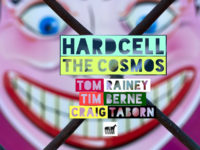by S. Victor Aaron
Jazz trios that push the envelope are a lot of fun to listen to. With only two other players to be accountable for, each member gets to take more chances than they might be able to get away with in a larger setting. And when it’s an unconventional getup, like say, a sax, drums and accordion, there’s bound to be even more surprises in store.
That’s the kind of getup Ellery Eskelin, Andrea Parkins and Jim Black has presented to audiences since their first joint effort Jazz Trash back in 1994. While Black and Eskelin get to run down whatever path their muse takes them, Parkins is at once the one who often acts as the melodic center of the trio and the catalyst to prod the guys to greater heights. And she does this through imaginative use of an electronically processed accordion, keyboards and laptop sampling. Even if the “melody” is just blessed cacophony.
Parkins, incidentally, is no stranger to One Track Mind. She provided the squeezebox clamoring for attention among the ruckus in Nels Cline’s remake of Andrew Hill’s “Compulsion”. She has more recently played the same role as Esklelin/Parkins/Black in another trio featuring Cline on guitar and Tom Rainey on drums. I haven’t heard Cline’s trio yet, but I’m absolutely certain that their two records (Ash and Tabula and Downpour) are good ‘uns.
Anyway, back to the Eskelin-led trio. Ellery Eskelin’s tenor follows much the same path as cohort David Liebman in that he starts from a position of more traditional forms of hard bop jazz while gliding over to free-form blowing when the situation calls for it. Jim Black brings a hard-driving rock drumming attitude to avant garde jazz, but is equally adept at handling all the change-ups that this trio’s music call for.
While their records have been consistently good, 2003’s Arcanum Moderne may be one of the strongest overall and I was tempted to just do an entire album review. But instead I’ll pick out one track which is more or less representative of their style of improvised music.
“43 RPM” begins with an urgent sounding jazz organ two-chord statement bleated out from Parkins’ keyboard. Black’s drums charge ahead like a runaway freight train while Eskelin blows long notes within the thematic statement. Then as soon as the chords go away, everyone goes into freak mode; Eskelin takes his flights up and down the scales, Black is stuttering his rhythm and Parkins is multitasking on her laptop, keyboard and amped-up accordion.
Like a child playing with a light switch, the song flips back and forth between the tonal and atonal mode. The third time into dissonance the band barely keeps from breaking down entirely as Black nearly (but not quite) spins out of timekeeping and Parkins’ smattering of sampling becomes a full-fledged wall of white noise. And right on a dime the band pulls together again back to the theme.
That’s a combo playing by very few rules. They disregard the boundaries between jazz, rock and experimental electronica and the resulting energy, musicianship and unpredictability make songs like “43 RPM” an irresistible listen.
Despite my picking this song out of obscurity, there is actually a video performance of it out there on YouTube. Well, sort of. The closing moments of this tune performed live with that signature two chord theme starts at about the 1:28 mark of this short, but charming homegrown trailer for a DVD documentary of the trio on tour in Europe. Check out the whole trailer for a quick introduction to one of the more unique and creative unsung units of experimental jazz in recent times:
- Christian Marien Quartett – ‘How Long Is Now’ (2024) - April 18, 2024
- Dave Douglas, feat. James Brandon Lewis – ‘Gifts’ (2024) - April 11, 2024
- Thollem – ‘Worlds In A Life, Two’ (2024) - April 8, 2024




